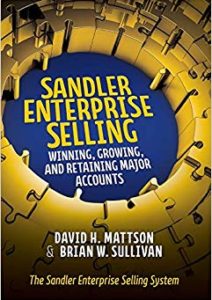I’m often asked how I define enterprise selling versus selling into small and medium-sized accounts. As is true of so much in selling, it’s all about pain – the driving force in causing prospects to act. But what about us as salespeople? Don’t we have to deal with pain as well? Of course. So, I define enterprise selling in terms of the unique pains and challenges that selling organizations face in seeking to do business with large accounts. Challenges like long sales cycles, wide buyer networks and the significant investments required in enterprise pursuits all create problems not encountered with smaller accounts. But the payoffs of winning major account deals are huge. For landing a new large client can be a game-changing, transformative development for selling organizations.
Given the daunting challenges, though, every organizational asset must be engaged to fortify enterprise pursuits to maximize the likelihood of winning. From account and opportunity planning to value-based solution development, effective selling organizations utilize sophisticated portfolios of tactics and strategies to add acceleration to these promising initiatives. But with all that rigor and process, a very fundamental item is often completely ignored.
So, let’s talk about this critical concept – fingerprinting. This familiar word brings to mind the process used by law enforcement agencies to identify criminals. We all have fingerprints, of course, and they’re our singularly unique physical characteristics. Those ridges and patterns on our fingertips are even more unique than our DNA. Really. Identical twins can share the same DNA but their fingerprints are always different. And when we touch surfaces, we leave our fingerprints behind. These images, uncovered by professional dusting techniques, provide strong evidence connecting us to scenes and situations, leaving their unique marks as undeniable evidence of the impressions we made.
Hold that thought and ponder this. If you planned to buy an expensive gift for your significant other, you’d conduct your due diligence with more vigilance than you’d use when shopping for everyday items. And if the potential purchase was on a “cash only – final sale” basis, you’d be even more focused as the stakes would be much higher. But regardless of the significant time and effort you’d spend, doubt and uncertainty would remain regarding whether your purchase would hit the mark. You would still be unsure about whether your gift would generate happiness commensurate with your time and effort. Why? Because you would not know for sure. Unless, of course, you took the time to preview the gift, or at least its concept, directly with your significant other prior to the purchase. Surprises aside, that conversation, testing the water about specific likes and dislikes, would greatly increase the chances that the item chosen would be spot on. The value of the feedback you received would be immeasurable in insuring that your gift, and you, would avoid being miserable failures.
The same concept applies to enterprise pursuits, with their significant organizational investments of money, energy and time. For a great deal of creativity goes into crafting your customized, account-specific solutions, which are the products of your team’s innovation, brainpower and hard work. Creativity and innovation aside, though, building a brilliant solution without credible, verifiable expectations that the account will find it acceptable is a dangerous and tone-deaf strategy. So, just as previewing an expensive gift with your significant other prior to making the buy is a strategic move, you owe it to yourself and your organization’s investment to strategically seek your account’s concurrence that you’re on the right track. This is “fingerprinting” or getting the account’s “fingerprints” on your solution. It’s sometimes referred to as “co-crafting” or “solutioning”, but whatever the term, it’s as close as you can get to a mandatory exercise in the world of major account selling.
In a previous life, I was involved in a pursuit in which we had planned on including an element of offshore delivery in our integration solution for a coveted prospect. Through a fingerprinting conversation with a trusted contact in the account, we were cautioned to reconsider our solution due to an organizational bias against offshore services, based on a recent negative experience with an IT provider that resulted in legal action. This wise and highly valuable counsel was sought, shared and acted on. We had strategically left time to restructure our solution and so we proceeded to switch out the problematic offshore component by substituting local services. This removed the red flag and paved the way for what turned out to be a very, very nice win. By seeking and getting the account’s fingerprints on our solution, the same type of miserable failure that had loomed with the expensive gift was thankfully avoided – all because we asked.
Of course, remember never to put your contacts in uncomfortable positions and also understand that some pursuits forbid certain types of communication. Be smart. Following the rules is always good advice. But if your relationships with the account aren’t strong enough to facilitate informal conversations with internal coaches, you should re-think your Go/No-Go on the pursuit altogether.
Account relationships are your dynamic assets. Build them, grow them and put them to work to get your clients’ fingerprints all over your solutions. One way or the other, good things will always happen.













Comments (1)
Very well written Brian… This is so true. i really liked the last statement where you mentioned Account relationships are your dynamic assets. Build them, grow them and put them to work to get your clients’ fingerprints all over your solutions. Its all about nurturing the account and building the trust factor with the clients .